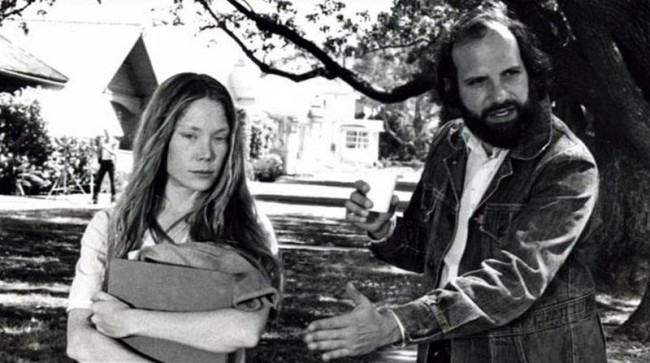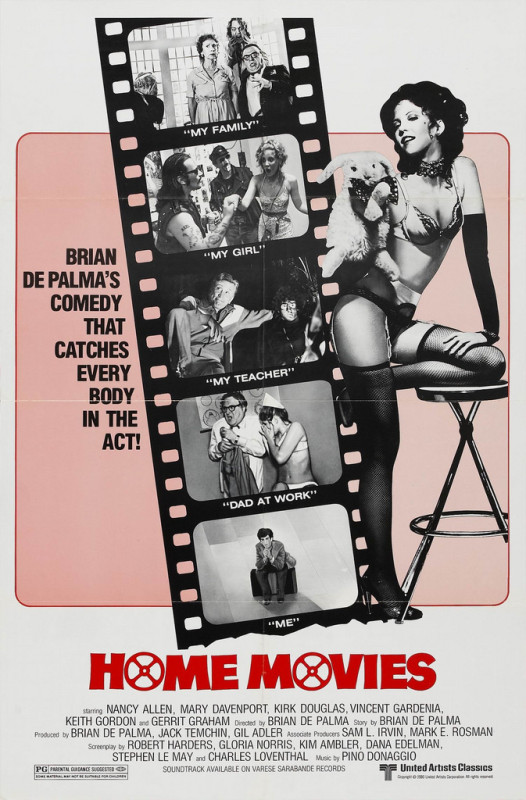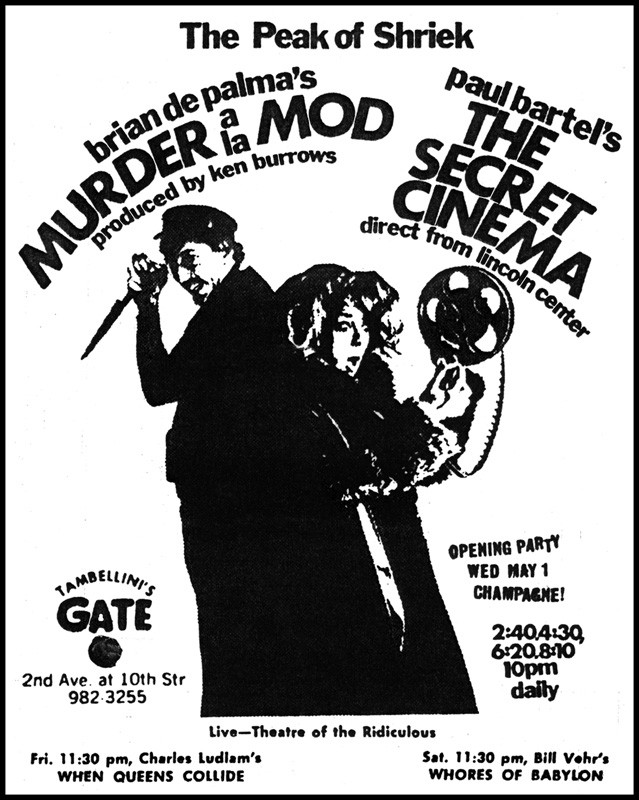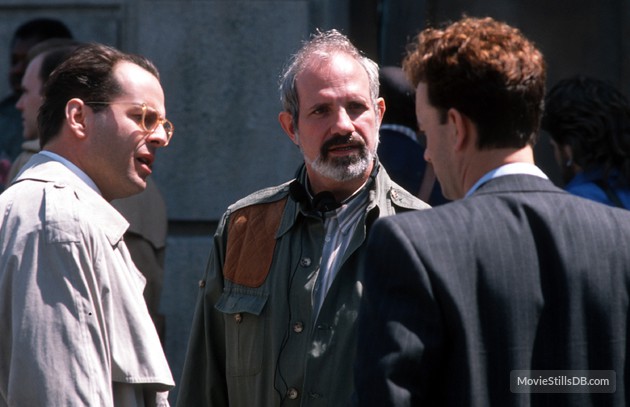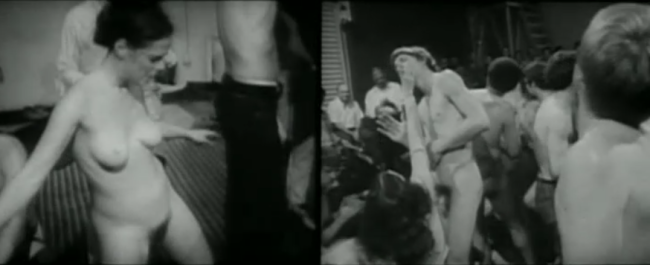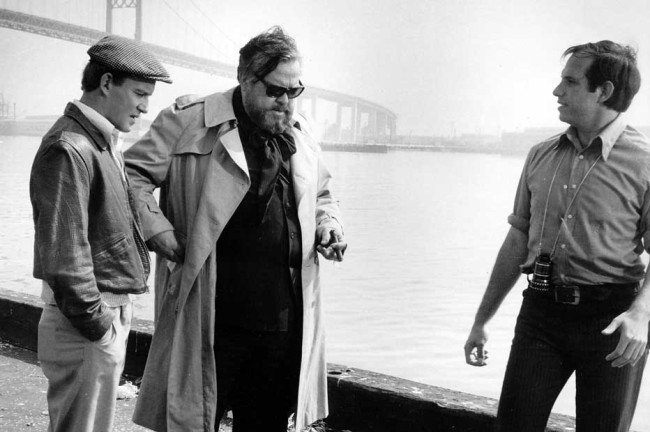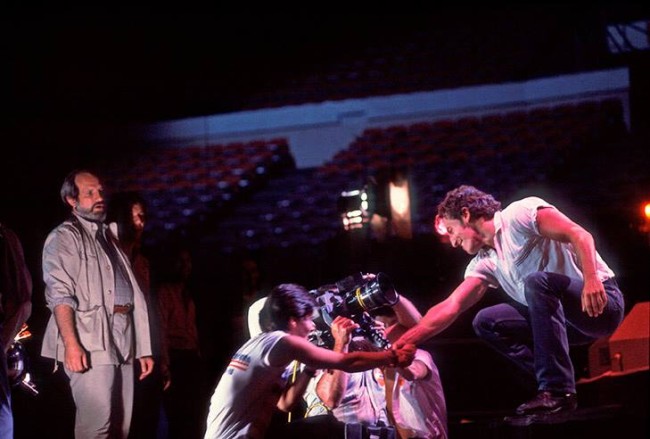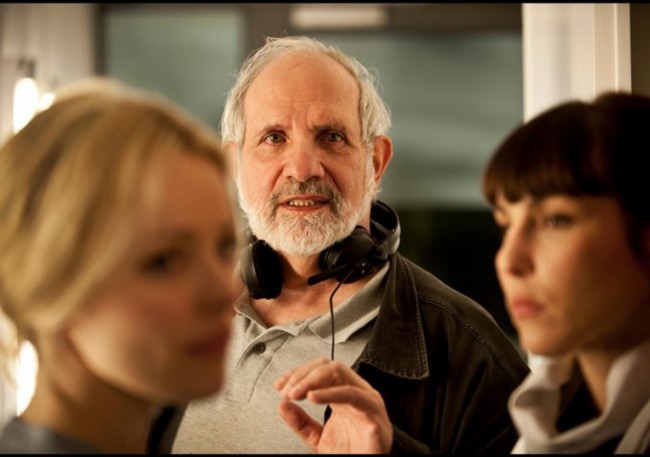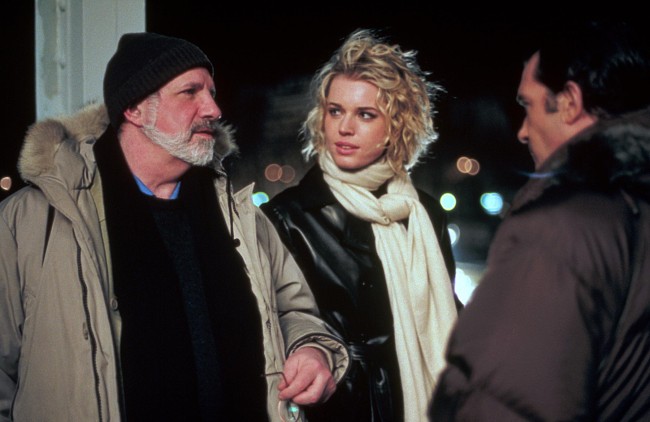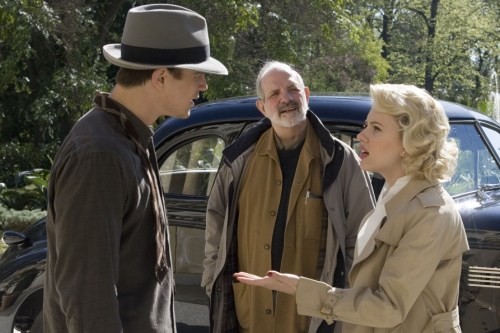By James Hancock February 24th, 2016
This past September I had the privilege of seeing the documentary De Palma at the New York Film Festival and found my obsession with De Palma’s films reaching a new high. I’ve been watching De Palma’s movies my entire life even before I knew who he was by name, but this was first time where I had the opportunity to appreciate his entire 50-year career in one sitting. After the screening, the directors Jake Paltrow and Noah Baumbach treated us to an interview with the man himself, Brian De Palma. At 75 years old, De Palma remains a fascinating raconteur but sadly he admitted that his legs aren’t quite what they used to be and that the physical demands of filmmaking might be more than he can handle moving forward. I wanted to argue that he could switch to animation or perhaps lose a little weight and increase his longevity, but from his tone he seems to be content with what he’s been able to contribute to the art form of cinema over the last half century. I can’t really argue with that position. Brian De Palma has been responsible for some of the most cinematic, high octane films I have ever seen including classics like Carrie (1976), Dressed to Kill (1980), Blow Out (1981), Scarface (1983), The Untouchables (1987), and Carlito’s Way (1993). If De Palma really is considering retirement, it time to look at his career as a whole. For those people out there less familiar with his work, I figured the least I could do is write up an introduction to his filmography along with my personal rankings of every film he ever made.
De Palma was studying physics at Columbia and was an admitted computer geek when he suddenly fell in love with movies. Abruptly he switched career paths and he eventually enrolled in a graduate program at Sarah Lawrence as one of their first male students in order to study film within their theater department. De Palma spent the 1960s making the type of experimental short films and features that have far more in common with the radical, guerrilla filmmaking of the early French New Wave than with the sophisticated thrillers and gangster films that would later define his reputation. But from the very beginning we see De Palma preoccupied with topics and themes that would inform nearly every film he ever made including political corruption, the technical side of filmmaking and most importantly, voyeurism which goes back to his childhood when he was trying to gather evidence of his father’s infidelities.
De Palma has built an entire career around photographing beautiful women, many of whom he’s become romantically involved with like Nancy Allen. He’s come under heavy fire repeatedly for the violent fates awaiting many of his female characters. My first argument would be that when dealing with thrillers and horror movies, people should have realistic expectations about what is in store for many of the characters. But a closer look at De Palma’s films overall will show that men and women both suffer grisly, violent deaths in equal measure. The finale of Scarface alone should more than balance the scales. If violence is not your thing in general, De Palma is probably not going to do much for you. But when it comes to action, I don’t know if there is a better director alive who understands so completely the need to establish the geography of a scene before the action unfolds. Contrary to the nausea-inducing shaky cam employed by some filmmakers today, when all hell breaks loose in a De Palma movie like The Untouchables or Carlito’s Way, the audience always has a perfect visual understanding of what is happening and consequently can savor every little detail. De Palma is an operatic visual storyteller who has a fundamental understanding of how to use the grammar of cinema to achieve a desired effect.
Before getting to my list I want to close with a quote by Roger Ebert about De Palma’s film Obsession that I found on Wikipedia that perfectly sums up why I and so many others love De Palma’s work, “Brian De Palma’s Obsession is an overwrought melodrama, and that’s what I like best about it…I don’t just like movies like this; I relish them. Sometimes overwrought excess can be its own reward. If Obsession had been even a little more subtle, had made even a little more sense on some boring logical plane, it wouldn’t have worked at all.” Roger Ebert at least understood what makes De Palma’s movies work. I’m always amazed and caught off guard by the vitriol spewed toward De Palma by so many. If you despise De Palma already, perhaps this list might persuade you to take a second look and reassess. But if you’re a virgin to De Palma and are curious about his films, I envy you. You’re about to take a very interesting ride.
(side note: I have not included De Palma’s early short films from the 1960s due to my being unable to find them in any format.)
30. Home Movies (1980)
While he was working on the screenplay to Dressed to Kill, De Palma taught a class at Sarah Lawrence College designed to give his students hands-on experience for all the various stages of film production. Made for little money relative to his more official productions of the time, Home Movies feels like a spiritual throwback to De Palma’s zany, experimental early work from the 1960s. De Palma called in some favors and put Kirk Douglas and Nancy Allen in the film but in the end Home Movies suffers from all the shortcomings one would expect from a student film. Compared to the amazing films to come over the next few years, Home Movies feels like a momentary distraction from De Palma’s true calling.
29. The Wedding Party (made in 1963 but released in 1969)
An ultra low-budget bordering on amateurish film, The Wedding Party was shot by De Palma in his early twenties but not released until six years later when one of its stars, Robert De Niro, began building a name for himself on the stage as well as his appearance in yet another De Palma film, Greetings (1968). The film’s style alternates back and forth, at times resembling the silliness of a 1920s Keystone cops comedy while at other times something closer to cinéma vérité. The story follows three young men over the course of a weekend where one of them is supposed to get married only to have second thoughts after spending a few days with his bride’s family. The chief attraction of the movie is De Niro, age 20 and credited as Robert Denero, who resembles a big chubby boy whose only thoughts are about girls and going to the beach. On its own merits, The Wedding Party is unlikely to knock your socks off but it is interesting to watch from a historical perspective if you’re interested in seeing what De Palma was capable of as a precocious young film fanatic.
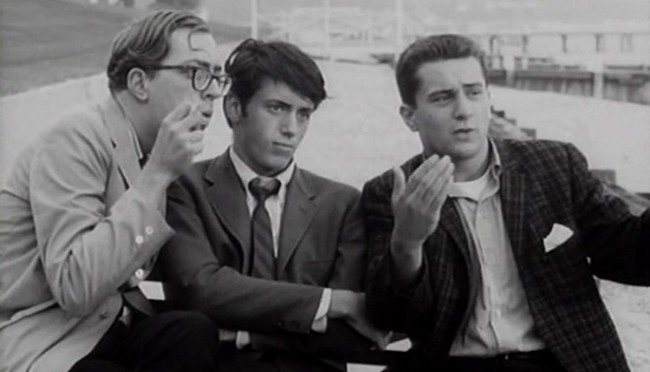
De Palma regular William Finley (left) & Robert De Niro credited as Robert Denero (right) in ‘The Wedding Party’
28. Redacted (2007)
One of Brian De Palma’s most controversial movies, Redacted dramatizes the true story of the rape and murder of a girl in Iraq by American soldiers. On a purely aesthetic level, De Palma told a similar story far more effectively in my opinion in 1989 with Casualties of War, but it was only a matter of time before De Palma’s frustration with America’s invasion of Iraq had to be expressed in his work. Shot in a found footage style, what holds the film back for me is the painfully amateur acting throughout the film. Rather than reinforce the documentary feel, the poor performances completely jar me out of the movie. I’m glad for De Palma’s sake that he was able to make a movie that meant so much to him personally and politically, but it is not a film I am eager to see again.
27. Mission to Mars (2000)
My understanding is that De Palma had an incredibly negative experience while making this movie, facing more than the usual level of studio interference due to the enormous scale of the film (estimated budget of $90 million). Throughout so many scenes in Mission to Mars it feels as if De Palma completely lost interest in the production. The screenplay feels unfinished, too many emotional beats fall flat, the cast lacks any real chemistry, and De Palma’s signature camera moves feel like an empty exercise at best. The last third of the film is little more than an excuse to show off the SFX budget with a climax seemingly taken from a completely different movie. If De Palma was involved at all at this stage of this film, his influence is certainly not felt on the screen.
26. Wise Guys (1986)
One of the most justifiably obscure movies in all of De Palma’s filmography, Wise Guys is a silly, broad comedy starring Danny DeVito and Joe Piscopo as low-ranking mob guys on the run after incurring the wrath of their psychotic employer. One of those movies that reinforces negative stereotypes about 1980s pop culture, Wise Guys does not possess a single frame of film that would alert anyone to the fact that De Palma was involved in the production. In a decade that is otherwise filled with nothing but incredible work by De Palma, Wise Guys is a total anomaly.
25. Murder a la Mod (1968)
The first film written and directed by Brian De Palma to be released, Murder a la Mod played on only one screen in New York before vanishing for many years. For fans of De Palma’s later masterful thrillers and their preoccupation with voyeurism, the porn industry, and murder, Murder a la Mod is a crucial step in De Palma’s development as a filmmaker. While today De Palma fans can easily see how at this stage he was still learning his craft, the film does feature a few directorial flourishes like POV shots of a killer wielding an icepick, a trope that would be popularized in slasher films in the following decade. Luckily the film has been preserved and we can thank the good people at the Criterion Collection for including the film on the Blu-ray release of Blow Out (1981).
24. The Bonfire of the Vanities (1990)
When people say, “But the book was better,” The Bonfire of the Vanities is the movie they have in mind. Based on Tom Wolfe’s riveting bestseller, disappointment does not begin to cover it when it comes to just how poorly his material was adapted. De Palma has very publicly distanced himself from this debacle, one where studio meddling led to a watered down story in an attempts to make Tom Hanks’s character more sympathetic. Apparently Bruce Willis’s ego was also running amuck derailing the production schedule whenever possible. The gory details of the production can be further explored in the book The Devil’s Candy by Julie Salamon. De Palma had given Salamon full access to the set and later stated that he found the book to be an accurate portrayal of the chaos behind the film. Today, the only real redeeming quality the film has to offer is the chance to see Melanie Griffith in full vixen mode even if her southern accent leaves a little to be desired.
23. Dionysus in ’69 (1970)
Using his famous split screen approach, Dionysus in ’69 is a recording by De Palma of a wildly avant-garde stage play starring his good friend William Finley, who starred in many De Palma films. Using the Greek tragedy The Bacchae by Euripides as a jumping off point, the play is basically 90 straight minutes of naked theater buffs caterwauling and rolling around, but with just enouogh intellectual pretension to maintain some artistic credibility. Well worth watching just for the sheer spectacle, this is less a movie and more an interesting record of the theater scene in Manhattan at that time.
22. Get to Know Your Rabbit (1972)
Get to Know Your Rabbit marks a very clear pivot point in De Palma’s career where he accepted his first assignment directing a movie for a major studio. Unfortunately the experience was only the first of many negative experiences in Hollywood and De Palma was fired before completing the movie due to creative differences with Warner Bros. The film was finished without De Palma and not released for several years. Luckily, some of what remains still manages to work in particular those scenes where Orson Welles instructs Tom Smothers on how to be a tap dancing magician. I’m obsessed with Orson Welles, an experienced amateur magician in his own right, so at the very least these scenes for me make the movie worth watching.
21. The Fury (1978)
The Fury has plenty of defenders but for me, it feels like a transparent attempt to cash in on the enormous success of the telekinetic chaos featured in Carrie in 1976. The screenplay for The Fury is all over the place but the gist of the story follows Kirk Douglas in his efforts to rescue his son who has been kidnapped by John Cassavetes in order to harness his dangerous psychic abilities. Along the way Douglas teams up with Amy Irving, who possesses similar powers to Kirk’s son, and the movie eventually ends with in a telekinetic tragedy of exploding body parts. I enjoyed John Williams’s attempts to craft a score in the spirit of Bernard Herrmann but overall The Fury can’t hold a candle to Carrie.
20. Greetings (1968)
One of De Palma’s most personal early films and the first that enjoyed any box office success, Greetings stars Robert De Niro as part of a trio of friends who spend most of their time trying to get laid or dodge the draft. It is a story De Palma was very prepared to tell in that he spent most of his college years trying to maintain good enough grades to stay out of the war in Vietnam. Greetings is clearly a movie where De Palma is trying to find his footing as a director but a lot of the movie works surprisingly well. In a plot line that carries over to the sequel Hi, Mom! Robert De Niro’s character dreams of directing a series of erotic films called ‘Peep Art’ featuring sex scenes through the windows of buildings around Manhattan. In one of the funniest scenes, De Niro stumbles clumsily through an elaborate ruse trying to get a girl to undress for him for the first time on camera. Not a bad movie by any stretch of the imagination, Greetings is the first evidence of De Palma’s incredible future potential as a filmmaker.
19. Dancing in the Dark (music video, 1984)
While no one is likely to rank this music video among De Palma’s greatest work, anyone who grew up in the 1980s can’t help but have some sentimental affection for this video. The video is worth watching if only to see a very young, awkward Courteney Cox getting up on stage to dance with the Boss.
18. Passion (2012)
There’s a good chance that Passion might end up being Brian De Palma’s last movie. While I would never argue that he’s retiring with his best movie, on the other hand, Passion is far from his worst. For the first half, the film has all the atmosphere and stylistic flourishes one would want from an erotically charged thriller courtesy of De Palma. Rachel McAdams is outstanding as a cutthroat exec at an ad agency using sex and deceit to manipulate, seduce and outmaneuver everyone around her including her protégé played by Noomi Rapace. For me, the story sadly comes unwound toward the climax but in spite of these structural shortcomings Passion remains a film that all of De Palma’s fans should see.
17. Femme Fatale (2002)
I have to confess that it has been well over a decade since I have seen this movie but Femme Fatale features two scenes that are still crystal clear in my memory to this day. The movie stars Rebecca Romijn as a con artist/thief who we’re introduced to at the opening with an extraordinary sequence where her character seduces a supermodel clothed only in expensive jewelry in order rob her blind without her noticing. What follows is a bizarre plot where Romijn uses the suicide of her doppelgänger to assume her identity and disappear only to realize at the end ***spoiler alert*** that it was all a dream. But before the finale we are treated to what might be the sexiest striptease ever committed to film, a vivid reminder as to why Rebecca Romijn was at one time one of the most famous supermodels on the planet.
16. The Black Dahlia (2006)
As soon as I heard that De Palma was working on an adaptation of James Ellroy’s extraordinary crime thriller The Black Dahlia, I assumed the final film would be nothing short of a masterpiece. The novel is one of the darkest, most disturbing crime sagas I’ve ever read and I thought it fit De Palma’s sensibilities perfectly. Unfortunately, the final film fell well short of my hopes for the material. The real drawback of the adaptation is the unwillingness to go as far to the dark side as Ellroy was willing to go in his text. The problems are compounded by the supporting cast who all seem to think they need to do their best Edward G. Robinson impression just because they are working in a period film set in 1940s LA. The scenes that play best are those where Mia Kirshner as Elizabeth Short is auditioning for a stag film where the director is played by Brian De Palma himself. De Palma is surprisingly good and makes me wish he had chosen to appear in more of his movies.
FOR #15-1 CHECK OUT DE PALMA: FIFTY YEARS OF FILMMAKING PART II
I am one of the Co-Hosts of Wrong Reel and you can find more of our content here:

